Here are some key topics we’ll be covering in this blog:

Hip pain walking up stairs is a common complaint for many people. Sometimes this is experienced as an intense pain in the hip area when lifting the leg or transferring weight onto the leg to push up a step, and other people experience a dull ache which might increase with the number of steps. But why does your hip hurt walking up stairs in particular and what can you do to reduce your hip pain going up stairs? These are common questions that we are often asked, as physiotherapists (physical therapists).
There are a number of different conditions and causes for hip pain walking up stairs. These can be different, depending on which area of your hip hurts walking up stairs. We’ll be covering all of these aspects in detail, so read on to find out more.
Here are some key topics we’ll be covering in this blog:
Recovering from Gluteal Tendinopathy, Trochanteric Bursitis or GTPS
FIRST LESSON IS FREE!
There are many reasons that going up stairs may result in more hip pain than other activities. Below we’ve outlined some of the common causes of hip pain walking up stairs.
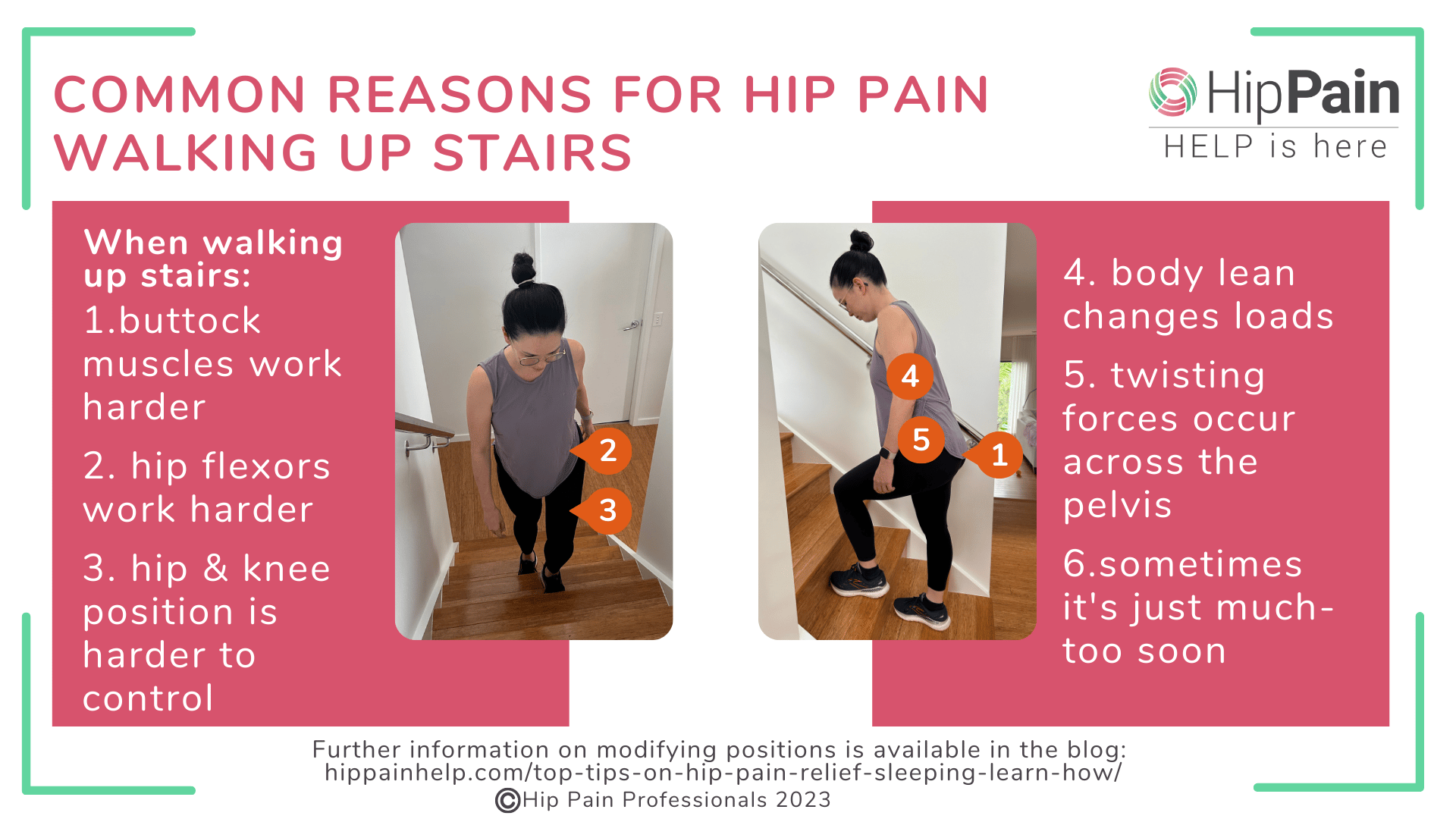
Walking up stairs places more demand on your hip muscles, working to push the weight of the body up over the foot against gravity. In a study that looked at the activation of the gluteus maximus (your biggest buttock muscle) during different exercises, a step up used 4-5 times more muscle work that a squat.1 Going up a step is hard work!
The hip flexor muscles are the muscles at the front of the hips. To walk up stairs, these muscles need to lift the weight of your leg, to place it on the next step. A leg is heavy!
Compared to walking on the flat, greater hip flexion (bend at the hip) is required when walking up stairs The higher the step, the greater the hip flexion, the more work your hip flexor muscles need to do. If you already have sore hip flexors, or you are not used to climbing stairs, the hip flexor muscles may become irritated due to the increased workload of lifting the leg.
The deepest hip flexor muscles also have a close relationship to the hip joint capsule. Hard hip flexor work may tug on these irritated joint structures in certain conditions, and cause hip pain walking up stairs.
As we discussed in the point above, walking up stairs is hard work. Not only does the muscle system work harder but it is harder to control the relative positioning of your pelvis, thigh and body as you transfer your bodyweight onto the top leg to push to the next step.
Compared with walking, you might notice that your hips shift a lot more to the side when climbing stairs. You might also feel your knee drop inward, and your body lean a little more to the side, due to the effort of pushing up stairs.
This movement pattern – hip out to the side, knee in towards the middle +/- and increased body lean – may add to irritation of certain conditions related to the hip joint (hip osteoarthritis, labral tears, hip dysplasia), the soft tissues at the side of the hip (gluteal tendinopathy, GTPS, trochanteric bursitis).
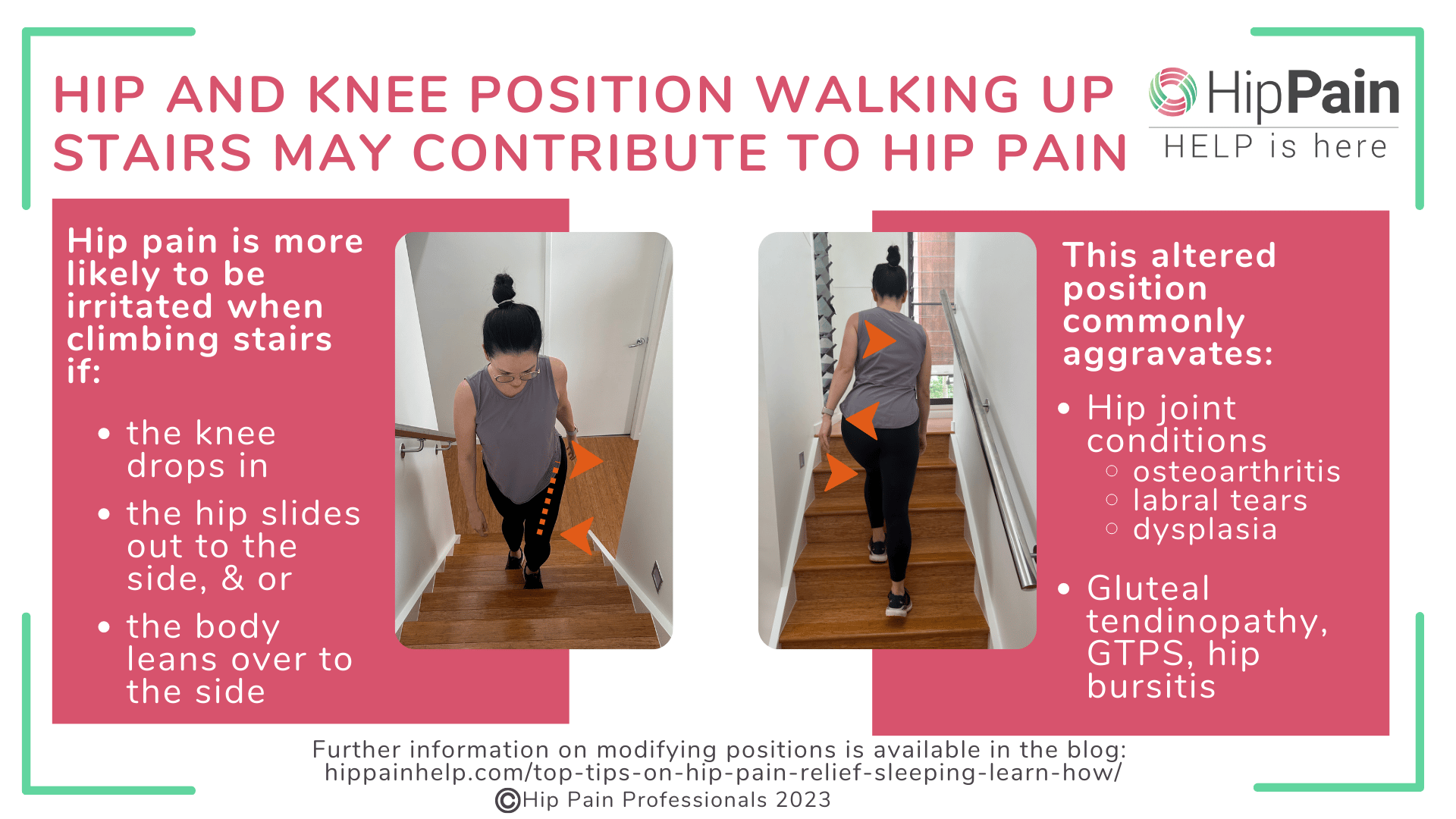
When walking up stairs, it’s natural to lean your body a little forward, but this might be one of the reasons your hip hurts walking up stairs but not down stairs or on the flat.
Leaning forward is not dangerous of course, but certain structures carry more load when your body is leaning forward. If these structures are already irritable, you might feel back, pelvic or hip pain on stairs, particularly if you are leaning further forward than normal, or if you’re climbing higher steps or a lot more steps that you are used to climbing.
When your body leans forward of the line of your hips (if your chest bone is sitting in front of your pelvis), the muscles at the back of the hip and thigh and the lower back muscles work harder.
This is simple physics! When the body leans forward from the hips, gravity acts to push the weight of the body towards the ground. The muscles on the opposite side of this lever must work to balance these forces. Health and exercise professionals often use this fact to help strengthen the gluteal, hamstring and back muscles in exercises such as deadlifts and squats, and even step ups.
However, sustained or repetitive contraction of the back and posterior pelvic (buttock) muscles may irritate hip, back or pelvic (sacroiliac joint) pain, due to the compression of the underlying joints. In a forward lean position, those with a shallow hip socket (hip dysplasia) will also experience greater forces on the back edge of the socket.2
Soft tissues such as muscles and tendons can also become fatigued and/or painful due to this sustained forward lean position, combined with the work of pushing up stairs. Back, buttock and hamstring muscles in the back of the thigh, or the hamstring tendon attachment at the sitting bone (ischium) may become painful.
Sciatic nerve pain climbing stairs may also occur when you have sciatica, deep gluteal syndrome, or piriformis syndrome. This is because the nerve is on more stretch when the body is leaning forward and the hip is bent. Also, as the muscles are working harder, they are hugging a little tighter around the nerve as it runs through the buttock. So, if the nerve is irritable or sensitive, you might feel the buttock pain in stair climbing more than during walking on the flat.
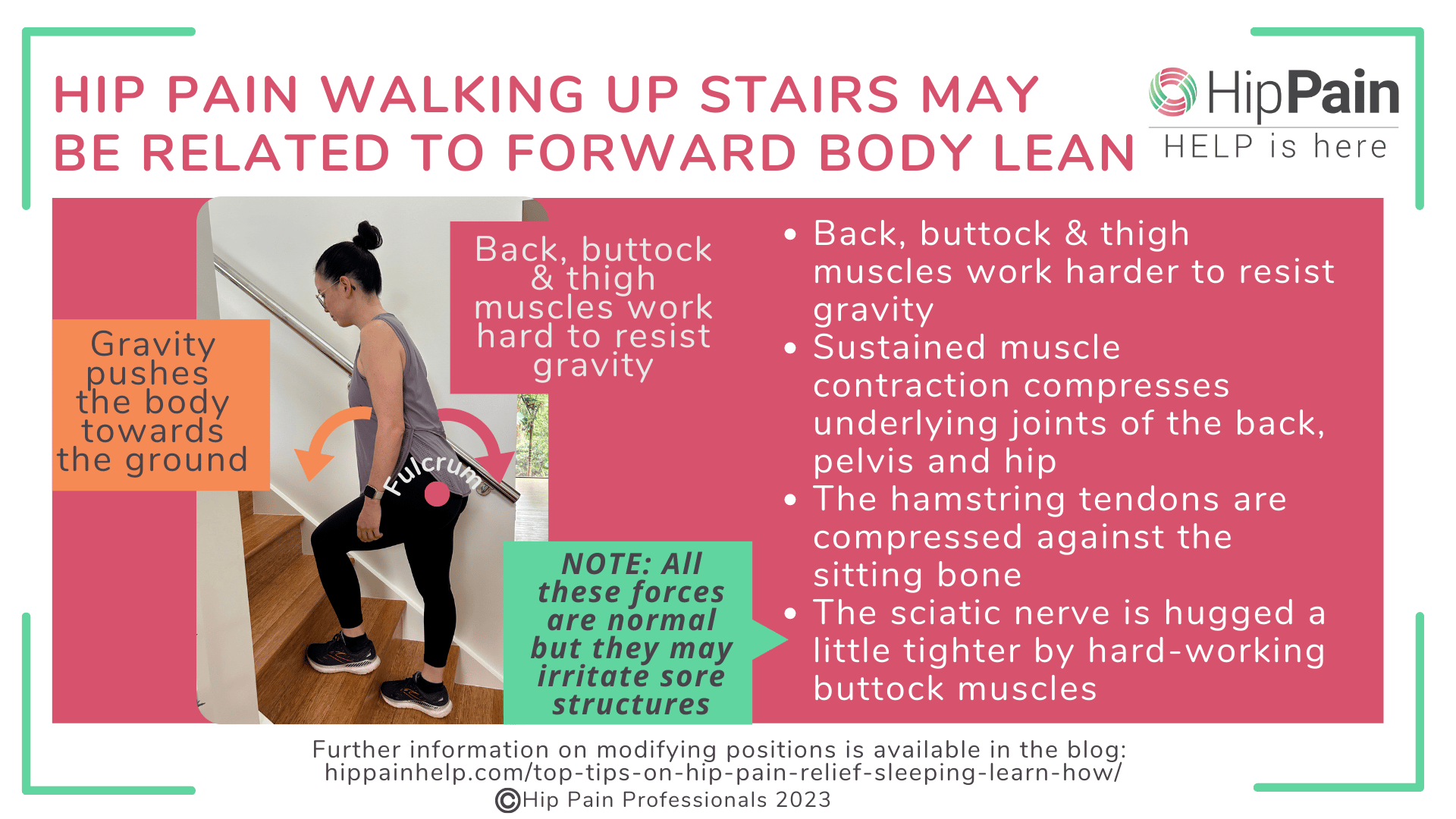
Stairclimbing can be more difficult and painful in the later stages of pregnancy. The action of stair climbing means that one leg is moving forward while the other is moving back. This creates some torsional or twisting forces across the pelvis, which can be harder to control when the pelvic ligaments are more relaxed in later pregnancy.
If you’ve been having pain over the sacroiliac joints (posterior pelvic pain) or pubic symphysis (the joint at the front of the pelvis), you might find walking up stairs is more challenging than walking on the flat, and sometimes painful.
Most normal stairs do not result in enough bend at the hip to bring it close to the end of its range of motion. However, if you are stepping up a large step in the garden for example, or at the gym, the hip might reach a position of deep flexion – where the thigh and the pelvis come close together.
Repetitive motion into this position may irritate joint related conditions such as osteoarthritis, femoroacetabular impingement syndrome (hip impingement, FAI, FAIS), hip dysplasia or labral tear.
Across the causes above, you will have read ‘if you are not used to steps’ a number of times. Musculoskeletal pain will often occur simply when you do too much, too soon. Suddenly taking up high box step-ups at the gym or swapping to taking 4 flights of stairs at work, when you usually take the elevator, may result in sore muscles. But it might also result in aggravation of pain around the hips and pelvis, because of the challenges of stair climbing outlined above.
If you are unsure why you have hip pain walking up stairs, a consultation with a Hip Pain Professional, a professional that knows hip and pelvic pain, may be of benefit.
Hip pain walking up stairs can occur in a number of different locations around the hip and pelvis. The area of pain can provide some clues as to what structures or conditions may be underlying the symptoms.
Pain at the front of the hip when climbing stairs is most commonly related to the hip joint structures or the soft tissues (muscles, tendons, bursae) at the front of the hip.
Less commonly, this pain can be referred from the lower back.
Much less commonly, the pain may be related to a bony injury due to trauma (e.g., a fall – bone fractures) or overload in those with osteoporosis or in endurance athletes.
If the reason for your hip pain is not clear, a thorough assessment with a health professional who knows hips, like a Hip Pain Professional, is recommended.
Recovering from Gluteal Tendinopathy, Trochanteric Bursitis or GTPS
FIRST LESSON IS FREE!
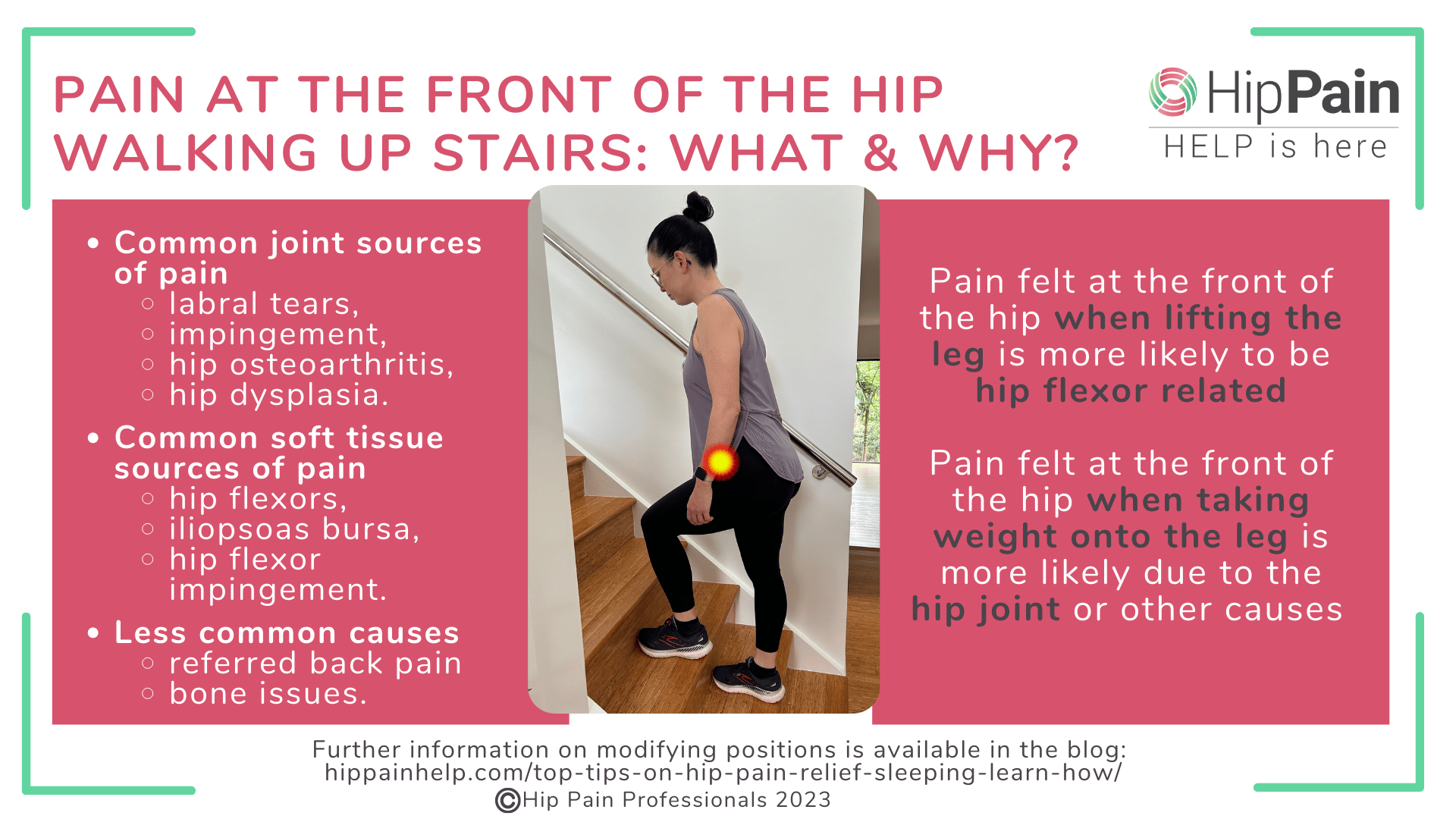
Common hip joint related conditions causing pain at the front of the hip include:
Common soft tissue related conditions causing pain at the front of the hip include:
Factors that often contribute to pain at the front of the hip walking upstairs include:
TOP TIP:
Be aware that the hip flexor muscles are blamed far too often for pain at the front of the hip. Your hip problems may well be underneath the hip flexors, in the hip joint.
How can you tell if your hip pain climbing stairs is from your hip flexors or your hip joint?
Pain at the outside of the hip when climbing stairs is most commonly related to the soft tissues (tendons and bursae) at the side of the hip.
Less commonly, pain at the side of the hip climbing stairs is related to the hip joint or referred from the lower back.
If the reason for your hip pain is not clear, a thorough assessment and individualised treatment plan with a health professional who knows hips, like a Hip Pain Professional, is recommended.
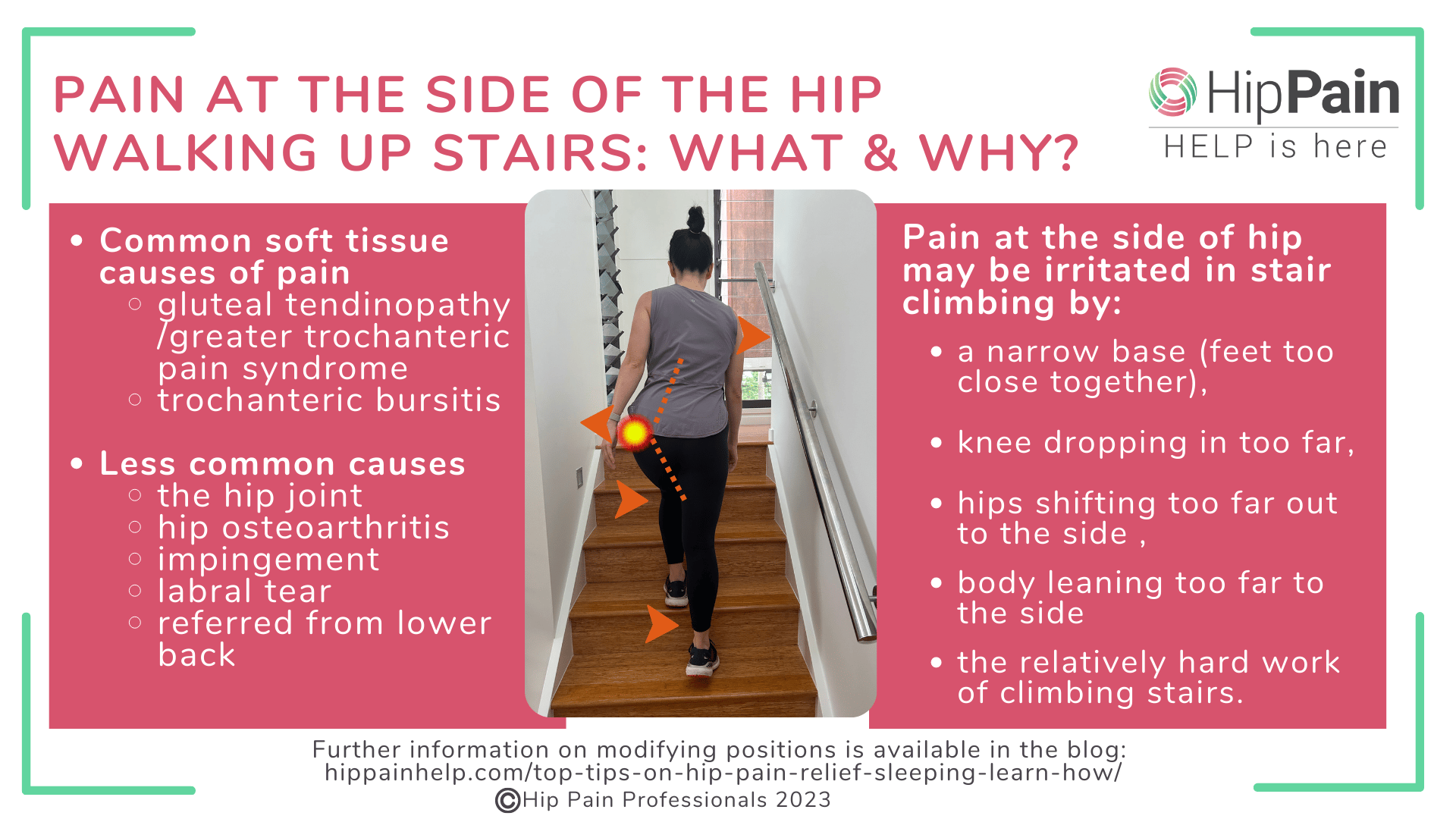
Common soft tissue related conditions causing pain at the outside of the hip include:
Gluteal tendinopathy, greater trochanter pain syndrome (GTPS), or trochanteric bursitis can also occur after hip replacement surgery. So if you develop pain over the outside of your hip after hip surgery, a common cause of hip pain here is tendinopathy or hip bursitis. External or lateral snapping hip is the less common and accompanied by a clicking that can usually be heard and/or felt over the bone at the side of the hip when climbing stairs.
Most likely hip joint related conditions causing pain at the outside of the hip include:
Recovering from Gluteal Tendinopathy, Trochanteric Bursitis or GTPS
FIRST LESSON IS FREE!
Factors that often contribute to pain at the outside of the hip walking up stairs include:
Pain in the upper buttock when walking up stairs is most likely related to the lower back, pelvic joints or the sciatic nerve as it exits the pelvis to travel through the buttock.
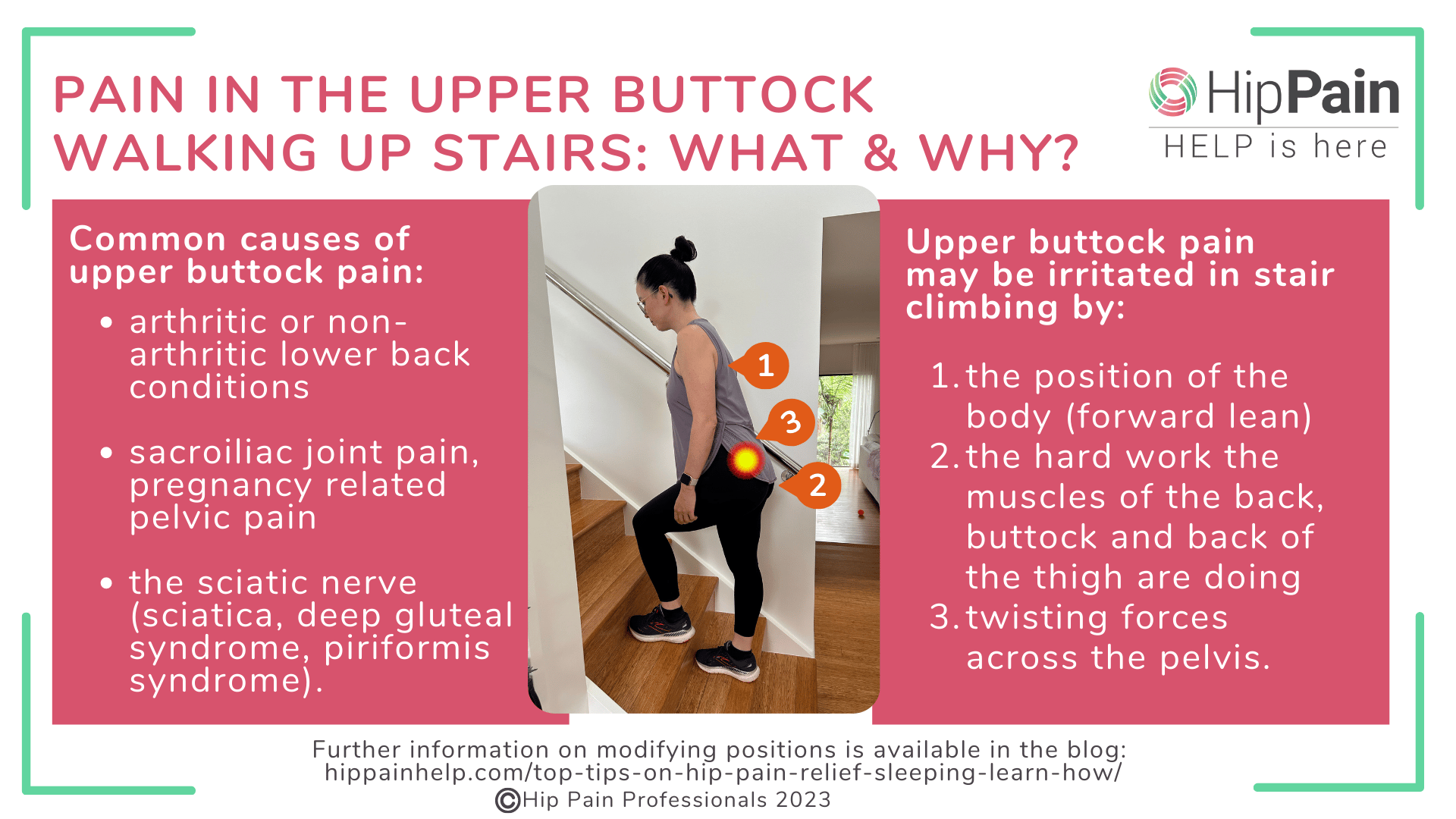
The most common source of pain causing upper buttock pain walking up stairs include:
Upper buttock pain walking up stairs can often be due to:
Pain in the lower buttock when walking up stairs is most likely related to the lower back, the hamstring tendons that join onto the sitting bone (proximal hamstring tendons), or the sciatic nerve.
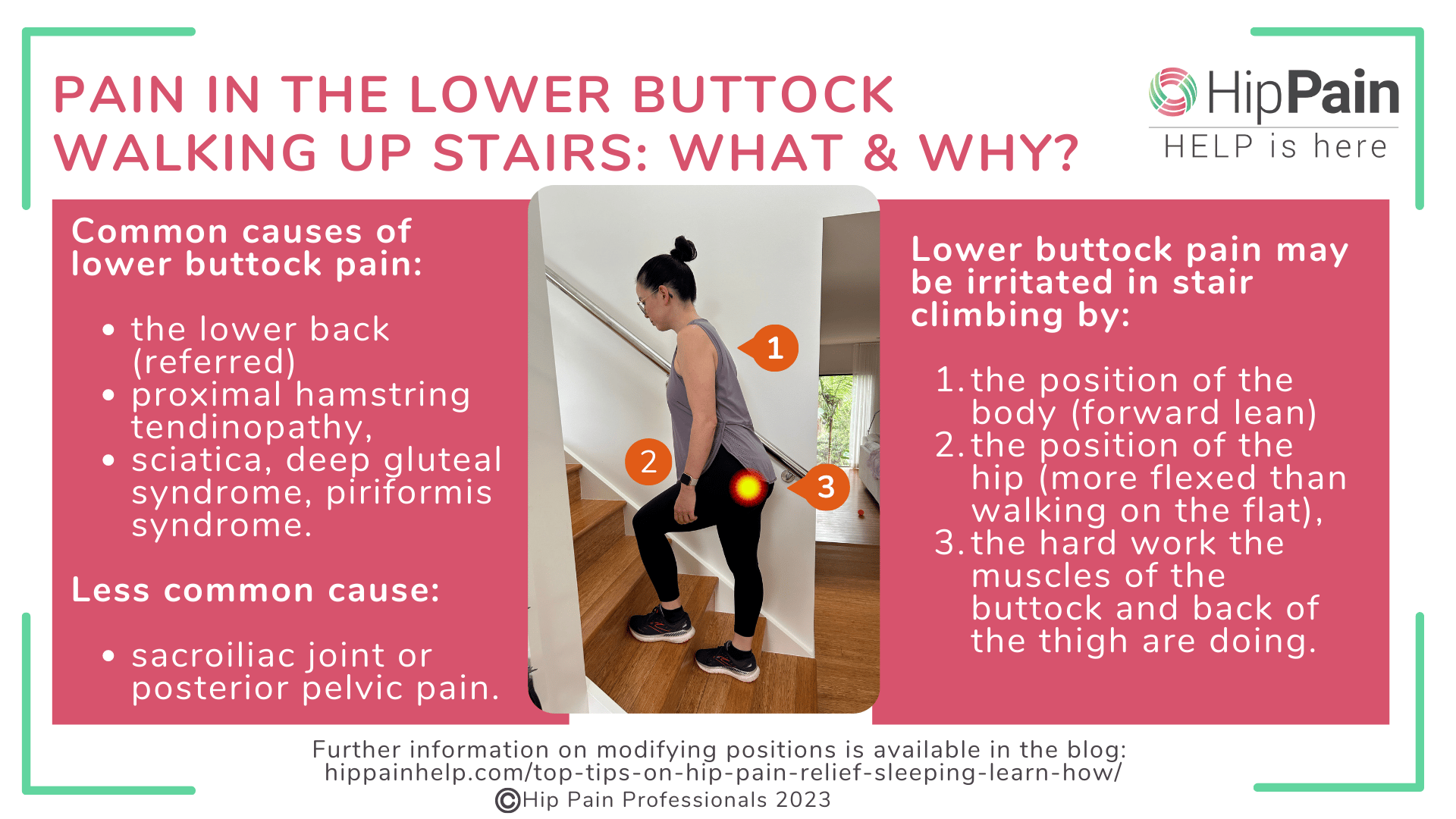
The most common conditions causing lower buttock pain walking up stairs include:
Lower buttock pain walking up stairs can often be due to:

While there may be many possible reasons why you have hip pain when walking up stairs, there are some good basic principles for climbing stairs that can help give you some pain relief. Try some of the tips below and see which ones work best for you.
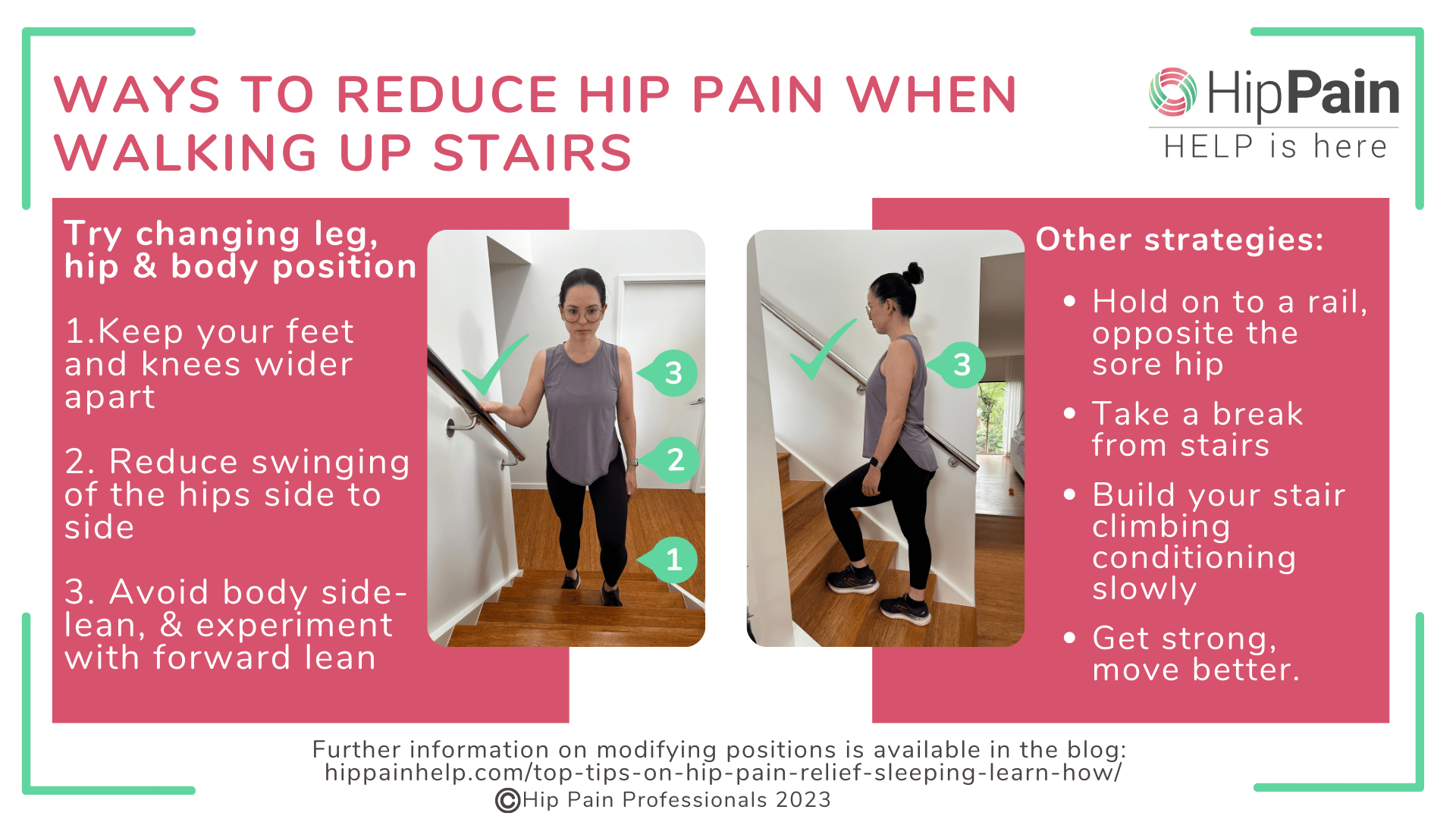
To reduce hip pain when walking up stairs, its a good idea to use a handrail on the side opposite your affected side. This will reduce the work done by the hip and thigh muscles and help you to better control your body, hip and knee position. A handrail is also useful for safety if your balance is reduced, particularly for older adults or elderly people.
You may need to increase or reduce your body lean, depending on the problem.
Swinging the hips excessively side to side can irritate pain at the side of the hip, as well as pain at the back or the hip and buttock pain. This can be due to muscle weakness, or it might simply be habit. As you transfer your weight to the top leg to step up, aim to reduce how far your hips shift to the side. At first, using a handrail can help you reduce this side-shifting of your pelvis.
If you have hip pain walking up stairs, try placing your feet hip width apart and keep your knees pointing more straight ahead. However, don’t force any position that doesn’t feel comfortable for your hips or knees. Start with small changes and see how they help. If you tend to walk with a narrow base and knees dropping in, try to improve this gradually. This strategy can help with many different causes of hip and buttock pain walking up stairs.
In some cases, the stairs might be too painful so try to keep them to a minimum and take lifts and escalators where possible.
You may need to take one step at a time, leading each time with your stronger leg. Carrying less when walking up the stairs can also help reduce pain. You may need to see an occupational therapist to help you decide if you need any stair aids at home, such as a handrail.
Stair climbing is great for general health, both for maintaining muscle and cardiovascular health. However, suddenly trying to climb lots of stairs when you are not used to stairclimbing in your everyday tasks or normal activities, may end up in some soreness somewhere. Start with what you know you can manage without soreness and then gradually increase – a simple rule for conditioning is to keep increases to 10% per week. Listen to your body’s response and modify accordingly.
Recovering from Gluteal Tendinopathy, Trochanteric Bursitis or GTPS
FIRST LESSON IS FREE!
If stairs continue to cause problems, build your hip and leg strength and improve your ability to control your body position in easier tasks like small range squats and lunges.
It is always worth seeking the help of a physical therapist to better understand your problem, why stairs are painful and what you need to do about it. Getting a careful physical examination including special tests and understanding your treatment options, can help ensure you get the right treatment for your hip pain. Physical therapy will involve a thorough review of your current physical activity, looking for daily activities that might be continually irritating your hip injury or problem in the hip region. They will be able to provide advice on specific activities you should or shouldn’t do, or how to modify them, and specific exercise that can help address any underlying causes. An exercise physiologist is another health provider skilled in helping you get stronger. Occassionally for more severe cases of hip pain, you might need to consult a sports medicine physician or an orthopaedic surgeon. They will be able to review or recommend pain medication and may recommend injections where appropriate, such as steroid injections.
Visit our Pain Locator Map to learn more about pain in different regions around the hip and pelvis.
This blog was written by Dr. Alison Grimaldi, with contribution from one of our Hip Pain Professionals, Kirsty McNab, experienced physiotherapist.
Dr. Alison Grimaldi is a globally recognised expert physiotherapist, researcher, and educator, who has over 30 years professional clinical experience helping patients recover from a wide range of hip and pelvic conditions.

Dr. Alison Grimaldi BPhty, MPhty(Sports), PhD, FACP
Dr Grimaldi has completed Bachelor of Physiotherapy, Master of Physiotherapy and Doctor of Philosophy (Physiotherapy) degrees. She is a fellow of the Australian College of Physiotherapists, Practice Principal of PhysioTec Physiotherapy, an Australian Sports Physiotherapist , an Adjunct Senior Research Fellow at the University of Queensland, as well as an author and global educator. Her passion is helping people with hip pain, and educating other health professionals around how to help more people with hip pain.
